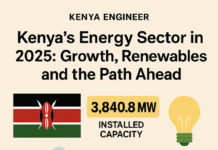Last Updated 7 days ago by Kenya Engineer
More than $44 trillion—over half of global GDP—relies on ecosystem services provided by nature. Yet, biodiversity is now declining faster than at any time in human history, threatening livelihoods, economies, and resilience against climate change.
A new report, The Foresight of Nature-Positive Engineering, released by Lloyd’s Register Foundation in partnership with the International Coalition for Sustainable Infrastructure (ICSI), outlines how the engineering profession can take a leading role in reversing this decline. By embedding nature-positive engineering (NPE) into infrastructure development, the report argues, engineers can help halt biodiversity loss while unlocking significant economic opportunities.
Engineering’s Responsibility and Opportunity
For decades, infrastructure has driven human progress but at a cost—high carbon emissions, habitat destruction, and resource depletion. The report stresses that infrastructure could instead become a key lever for restoring nature if developed through NPE principles.
Savina Carluccio, Executive Director of ICSI and author of the report, explained:
“Engineering has long driven human progress, but it has also contributed to ecological degradation, biodiversity loss, and climate instability. Today, engineers face both a responsibility and an opportunity to become stewards of the natural systems we all depend on. This demands a fundamental shift in infrastructure development—moving from viewing nature as a constraint to recognising it as a critical ally.”
NPE seeks to move beyond minimizing harm to actively protecting, restoring, and enhancing ecosystems, delivering measurable ecological gains while also meeting human needs.
Early Applications of NPE
The report highlights practical examples of NPE already in use within three sectors:
-
Coastal protection – Living shorelines reinforced with native vegetation.
-
Offshore renewable energy – Fish hotels incorporated into wind farms to protect species from predators.
-
Ports – Marine protection structures enhanced with ecological features.
These case studies demonstrate that integrating nature into engineering design can strengthen infrastructure resilience while improving biodiversity outcomes.
Recommendations for Scaling NPE
To move from pilot projects to mainstream adoption, the report sets out three key recommendations:
-
Create a policy-driven enabling environment – Embed NPE in planning, procurement, and regulation.
-
Build technical capacity – Launch toolkits for professionals and integrate NPE into engineering education.
-
Form a global alliance for NPE – Foster knowledge-sharing and showcase best practices across regions and sectors.
Unlocking Economic Potential
The stakes are high: over half the world’s GDP is directly tied to natural systems. Moreover, experts estimate that three-quarters of the infrastructure needed by 2050 is yet to be built, presenting an unprecedented opportunity to embed NPE principles from the outset.
Jan Przydatek, Director of Technologies at Lloyd’s Register Foundation, emphasized the urgency:
“Critical infrastructure is essential to keeping people safe and supporting economic activity, but it doesn’t need to come at the expense of biodiversity. It’s time to go beyond carbon-neutral infrastructure that minimizes harm to fundamentally transform the way we approach the built environment for the next generation.”
Global and Local Relevance
Although the report focuses on coastal and marine environments, its findings are equally applicable to infrastructure development on land. For countries like Kenya, where coastal cities face rising sea levels and inland regions are under pressure from climate-related stresses, NPE offers pathways to build climate-resilient infrastructure while safeguarding ecosystems.
Methodology
The report’s findings are based on a rigorous global consultation process, including:
-
Five roundtables involving over 200 stakeholders from 30 countries.
-
30 interviews and focus groups with subject matter experts.
-
An open global call for input.
-
A comprehensive review of literature, case studies, and existing resources.
Participants included engineers, government agencies, academics, civil society organisations, energy firms, port operators, and financiers, ensuring a broad and inclusive perspective.

























